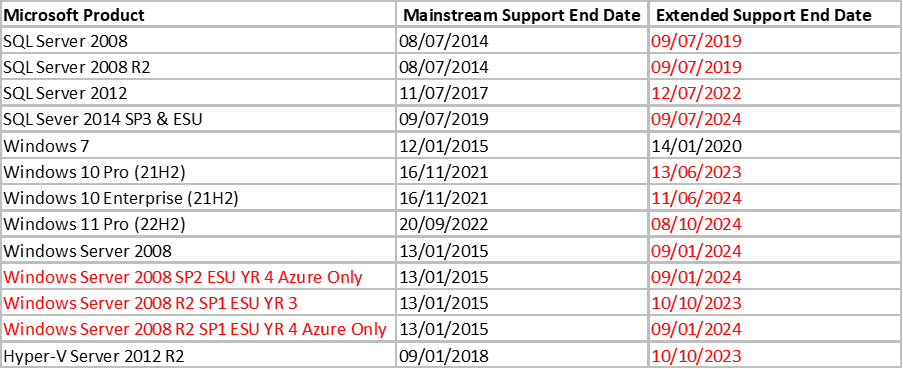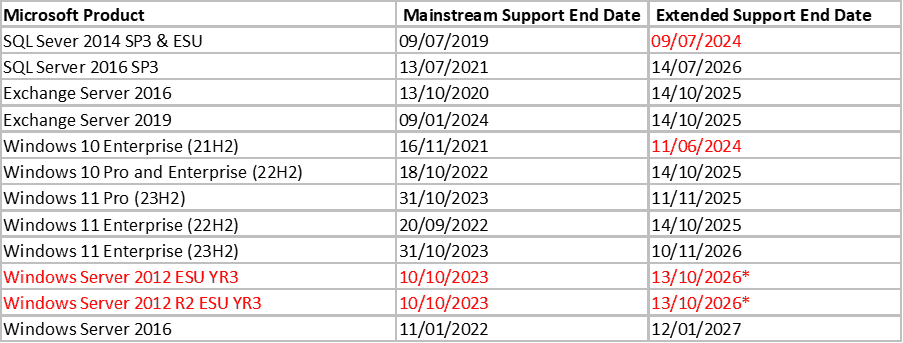Microsoft End of Support: what help is available?
It’s a fact that legacy operating systems and workloads are often unsupported by their manufacturers. When you combine this with the current time-to-exploit for any newly discovered vulnerability, there is tremendous pressure to assess the risk and implement any mitigations and remediations as quickly as possible.
Depending on the strategy of the business, this may impact current plans around IT infrastructure refreshes and long-lead IT transformation plans. The criticality of the business plans versus the risk of a very costly security incident needs options to suit the strategy of the business.
Some business may need more time for their transformation activities in their on-premises environments, while others may have business critical risks that need a quick and cost-efficient migration option to extend the lifecycle of legacy systems.
Whatever your situation, they are both impacted by the risk of operating unsupported systems. This article examines what Microsoft’s end of support signifies, and lists the products affected and when. We also share our knowledge of what you need to do about it.
What does Microsoft End of Support mean?
This means that once a product reaches its ‘Extended Support End Date’ there will be no patches, security updates or support from Microsoft. If you’re using any of these products and do nothing, it’s almost certain that your risks around security and compliance will increase, which may also impact productivity. These risks will only grow over time, so it’s vital you act. Advania are here to help you.
Why does Microsoft end support for its products?
In brief, they can focus their investment on supporting newer and better technologies and improved user experiences.
What Microsoft products are coming to the end of their support?
Support for several popular Microsoft products has ended or is ending soon, notably:
- SQL Server 2014 SP3 and ESU on 09 September 2024
- Windows Server 2008 and 2008 R2 on 10 October 2023 (09 January 2024 Azure Only)
- Windows Server 2012 and 2012 R2 on 10 October 2023*
- Hyper-V Server 2012 R2 pm 10 October 2023
*Support is extendable by using Azure Arc on qualifying OS licensing (e.g. CSP subscription) with an ESU subscription or by migrating the server to Azure.
Act Now: Microsoft End of Support Coming Soon
If you’re using any of the products listed in the table below, you’ll find advice on your options towards the end of this blog.

Table notes: Support ends 12 months after the next service pack release or at the end of the product’s support lifecycle, whichever comes first.
All information is based on the support date for the most recent service pack for the product. Support for these products where the latest service pack is not applied has already lapsed. You can check the full details for the support milestone dates for your Microsoft products by visiting the Microsoft Support lifecycle website.
Think Ahead: Microsoft End of Support within the next few years
Support for the Microsoft products listed below ends in less than three years’ time.

*The extended support date for Windows Server 2012 and 2012 R2 is dependent on a qualifying license, and Azure Arc and ESU subscriptions.
Table notes: Support ends 12 months after the next service pack release or at the end of the product’s support lifecycle, whichever comes first.
All information is based on the support date for the most recent service pack for the product. Support for these products where the latest service pack is not applied has already lapsed. You can check the full details for the support milestone dates for your Microsoft products by visiting the Microsoft Support lifecycle website.
What are your options?
Fundamentally, we recommend modernising your workplace. Get modern and up-to-date by upgrading your workloads to the latest Windows Desktop, Server or Application versions and move them to a modern device or consider migrating your resources to Advania Cloudlab private cloud or Microsoft Azure public cloud to access extended updates from Microsoft or integrating Azure Arc with ESU subscriptions on qualifying servers in your on-premises datacenter.
If there are technical reasons why you can’t modernise your workplace, you have three core options, or you could decide to do nothing. The one you choose depends on the circumstances and needs of your organisation and users. Here are your options, together with additional information for different applications:
- Relocate your workloads to Azure: if you have an application or infrastructure constraint that’s keeping you on a legacy version, you’ll receive Extended Security Updates by running your workloads on the Azure platform.
- Complete an in-place-upgrade: If time is against you or if your connectivity inhibits your move to the cloud, then as a last resort upgrade your Windows Server 2008/2008 R2 and Windows Server 2012/2012 R2. Read Microsoft’s guidance here. Consider this a short-term plan until you’re ready to modernise and simplify your IT.
- Integrate Azure Arc and ESU subscriptions with qualifying on-premises servers. If you do not have qualifying licensing, you can purchase licensing through a CSP subscription to allow the use of Azure Arc for hybrid operations management which will support the deployment of patches under your ESU subscription.
- Do nothing: The sky isn’t going to fall in when Microsoft’s support ends, but your systems and applications will be increasingly vulnerable to cyber risk. Your workloads will be unsupported, and assistance will be very limited should they fail. This could affect your ability to pass cyber accreditations that may impact your cyber insurance policies and/or your ability to engage with certain customers.
Advice for your end-user compute workloads – Windows Desktop Operating Systems
If you’re running older or legacy OS on your desktop computers or in a VDI (virtual desktop infrastructure) environment, we strongly advise that you move to the latest Windows 11 build. This will equip your users with the most productive and secure Windows desktop to date. Windows 11 has a full feature update twice a year and gets improves with each release. Seize this opportunity to take advantage of the security, productivity, and management capabilities in Windows 11.
If something is preventing you from upgrading to Windows 11, you could migrate your Windows desktop workloads to Azure inside a VDI environment such as Azure Virtual Desktop or Windows 365 Cloud PC. You’ll get the Extended Security Updates for free, so your legacy workloads will be supported while you transition to Windows 11.
If you can’t move your workloads to Azure, you can buy the Extended Security Update add-on for your physical workstations. This is costly, however, and won’t mitigate all the risks of using legacy devices.
Advice For Your Server Workloads – Windows Server, SQL Server, Exchange Server
Assess the environment your server is running in – physical or virtual – and the applications running on top of your server operating system.
The modern approach is to migrate your application workloads to a Platform-as-a-Service (PaaS) or Software-as-a-Service (SaaS) environment. The cloud is evergreen and allows you to scale up or down as required, paying only for what you consume. Exchange Online, as part of Office 365 or Azure SQL Database, are great examples of Microsoft’s modern approach to mainstream server applications.
If you need to keep your operating system running on the same version, you can migrate your workloads to Microsoft Azure and get Microsoft’s Extended Security Updates for a further three years. Click the links to find details on how to move your Windows Server Operating Systems and SQL Server Applications.
You could also look at upgrading the servers in your offices or data-centres to newer hardware running the latest version of Windows Server. However, this is expensive when you consider the server and client access licenses as well as the power, cooling, and TCO of maintaining your hardware. Alternatively, we recommend upgrading your workloads and migrating them directly to Microsoft Azure or to our Advania Cloudlab private cloud platform depending on your business requirements.
Additionally, new options include using Azure Arc with CSP Windows OS and ESU subscriptions to manage your critical updates on qualifying Windows Server OS. Careful consideration should be given to the business case to ensure the most optimal model for the management of the server estate.
Explore our managed cloud services
We’ve helped hundreds of organisations to modernise and move to the cloud; we have the scale, knowledge, and years of experience to guide you. Our managed cloud services portfolio includes:
- Azure Public Cloud and if you’re not quite ready to make the leap, consider a phased approach.
- Hybrid Cloud – move what you can to the cloud now, while continuing to manage your legacy applications.
- Advania Cloudlab – our highly secure, Infrastructure-as-a-Service Platform
If you’d like guidance on the best plan for your organisation or support for your journey, contact us today.
A Quick Note About Windows 11
As mentioned, Windows 11 is updated twice a year. Microsoft maintains support for the current and previous two feature updates for Windows 11 before support is retired.
The exception to this is the Long-Term Servicing Channel (LTSB/LTSC). While Microsoft supports these releases for much longer than the semi-annual feature updates, it’s not the recommended service path for most organisations. LTSC releases are designed for regulated systems, such as workstations connected to MRI scanners where the operating system feature set cannot change.
- Windows 11 Enterprise LTSC is scheduled to be released in the second half of 2024.
Microsoft End of Support: Help and Resources
So that you can quickly access trusted links and current guidance, we’ve compiled this list:
Microsoft Lifecycle FAQ – Windows products
Microsoft’s Service Pack Lifecycle Policy
Microsoft Search by product name or time range for life cycle information
Microsoft Azure Virtual Desktop
Microsoft Windows 365 Cloud PC
Microsoft Azure SQL Database
Plan you Windows Server and SQL Server end of support: https://www.microsoft.com/en-us/windows-server/extended-security-updates
How to get Extended Security Updates (ESU) for Windows Server: How to get Extended Security Updates (ESU) for Windows Server 2008, 2008 R2, 2012, and 2012 R2 | Microsoft Learn
Prepare to deliver Extended Security Updates for Windows Server 2012: How to prepare to deliver Extended Security Updates for Windows Server 2012 through Azure Arc – Azure Arc | Microsoft Learn


















